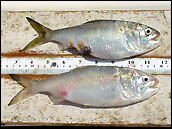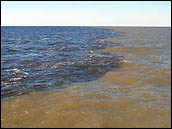

| The Ones That Got Away (Almost) | |||
Given the severity of the runoff and the pollution it carried, many scientists were surprised at how little impact it seemed to have on North Carolina’s aquatic ecosystem. In previous years, there were large fish kills after both Hurricanes Fran and Bonnie due to runoff and sewage sapping oxygen from the water. Hurricane Dennis, followed by the intermittent thunderstorms, may have played a role in shifting whole populations of animals eastward toward the ocean, surmises Joe Luczkovich, marine biologist at East Carolina University (ECU). Because the fish and shellfish prefer saltier water, it is possible that all the freshwater runoff in the weeks prior to Floyd prodded these animals to move toward the Atlantic and out of harm’s way. "It is hard to say if that is the case because we really didn’t get much data during these events," Luczkovich states. "Most folks take their boats out of the water when hurricanes are coming, so no one was out taking [in situ] data. Unfortunately, we are really only seeing a snapshot of conditions before and after [the hurricanes], and not much during." Ward suggests that Hurricane Floyd may have less severely impacted fish than
both Fran and Bonnie because it occurred a month later, when water temperatures
were much cooler. "The cooler the water, the higher the capacity for
oxygen," he explains. "The conditions that were right [after Floyd] to
produce low dissolved oxygen were offset by the cooler temperatures. The fish
kills after Bonnie and Fran may have been more of a problem because they occurred
during warmer months." |
 During the summer months over the last 10-15 years, usually after severe events like droughts or hurricanes, researchers have occasionally found populations of dead fish floating in the Pamlico Sound with open wounds on their bellies. State officials feared there would be similar fish kills following Floyd, but none occurred. (Photograph courtesy Pamlico River Rapid Response Team) | ||
An important piece of evidence came from the fishermen. While the catch in the rivers and estuaries was virtually nil, they caught white shrimp in droves just behind the boundary line where the runoff waters ended and the saltwater began. According to Ward, this boundary was actually visible on the surface–on one side the water was almost completely fresh and full of sediment, and the other side was the very salty water that got pushed out from the rivers and estuaries weeks earlier. Hordes of shrimp were schooling just on the seaward side of the line, but staying in close to the boundary, making them an easy catch. "Basically, [Hurricanes Dennis and Floyd] changed the ecology of the Pamlico River and Sound," Ward observes, "and just moved the fish and shrimp out to sea. Commercial fishermen with boats equipped to fish in the ocean had a big year. But those who are only equipped to fish the rivers were devastated." |
 After the hurricane, the boundary between the outflowing rivers and ocean water was unusually sharp. Fisherman profited because shrimp, pushed out of the estuaries by runoff, clustered along the ocean side of the boundary. (Image courtesy Neuse River Estuary Modeling and Montoring) |